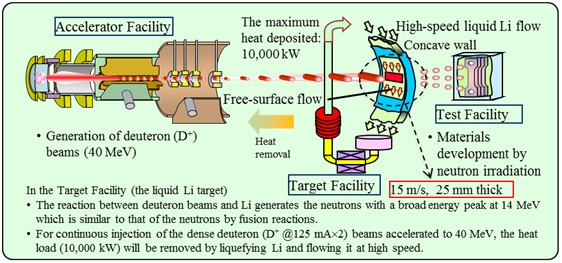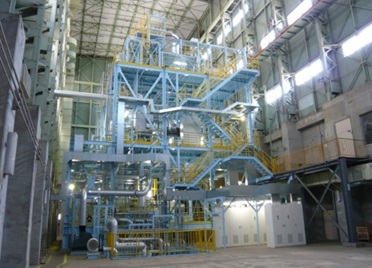December 22, 2014
Japan Atomic Energy Agency
Sector of Fusion Research and Development
Department of Fusion Reactor Materials Research
[Key achievements]
In the Broader Approach Activities (hereinafter referred to as "BA Activities")1) under Japan/EU Collaboration for an early realization of fusion energy, the full-scale engineering validation test of the high-speed liquid lithium (Li) flow for the fusion neutron source was performed. To realize a fusion reactor, irradiation tests and the evaluation of the fusion reactor materials are required under an environment simulating the high energy and high density fusion neutrons. Therefore, the construction of the International Fusion Materials Irradiation Facility (IFMIF) has been expected by various countries. Under the BA Activities, JAEA has performed the Engineering Validation and Engineering Design Activities for the IFMIF (IFMIF/EVEDA)2) mainly at the International Fusion Energy Research Center in Rokkasho Village, Aomori Prefecture.
The objective of the IFMIF (Fig. 1) is to generate fusion neutrons continuously for long hours by injecting dense deuteron (D+ @125 mA´2) beams accelerated to 40 MeV onto the free-surface Li flow of 260 mm wide and 25 mm thick at a linear velocity of 15 m/s. The thickness variation of the Li flow needs to be within a range of ±1 mm. However, the high-speed flow with a free surface tends to be less stable and the verification of the long-term stability has been a challenging issue.
The EVEDA Lithium Test Loop (ELTL, Fig. 2) with the world’s highest flow rate constructed at the JAEA Oarai Research and Development Center is 1/2.6 scaled model of the actual IFMIF Target, which was built based on the research achievements obtained in the past. The facility was constructed and operated utilizing the liquid sodium flow test facility, which handles the same alkali metal as for the fast bleeder reactor development in the Oarai Research and Development Center. The construction of the ELTL were started in June 2007, and the full-scale test has been performed since October 2012 and ended at October 2014.
A new surface wave height measuring method (laser-probe method) was introduced for measurements of the 3D geometry of the liquid Li target surface. Using these technology, it was verified for the first time in the world that the stability of the Li flow (the thickness variation of ±1 mm or less) satisfied the requirement of the actual liquid Li target of the IFMIF and a long-term stable liquid Li flow can be established, which resulted in the great achievement toward the construction of the fusion neutron source in the future.

Fig. 1 Overview of the IFMIF Facility
In the IFMIF, taking into account the width (200 mm) of the footprint hit by deuteron beam and the thickness (25 mm) making 40 MeV deuteron beam stop inside, the 260 mm wide and 25 mm thick Li flow with a free surface shall be generated steadily at a high speed of 15 m/s or more.

Fig. 2 EVEDA Lithium Test Loop (ELTL, Height: approx. 20 m, @JAEA Oarai R &D Center )
To stabilize the high-speed liquid Li target flow, the geometries of the nozzle which makes the flow and the flow channel needed to be improved. Therefore, the optimum geometries of the nozzle and the flow channel were designed and fabricated (Fig. 3) based on the fluid calculations by developing and utilizing the achievements of the joint research with the universities and the technical expertise about the liquid metal usage accumulated by the fast reactor development.

Fig. 3 The structure of the target section of the liquid Li flow test facility (left) and the Li flow realized in the liquid Li target under the actual facility environment (right). (Unit: mm)
The target section irradiated by the deuteron beams is shown, and the nozzle to flow Li along the concave wall steadily at high speed has a two-stage contraction structure, which is adjoined with the concave back plate having the gentle curvature change. The target section of the flow channel onto which the deuteron beams are injected is realized to be as thick as the 25 mm Li flow of the IFMIF actual facility, and the channel is 100 mm wide to sufficiently verify the behaviors and stability of the Li flow in the actual facility.
Using the liquid Li flow test facility, the liquid Li target was realized under the operation environment of the actual facility (vacuum: 0.001 Pa, temperature: 250ºC, velocity: 15 m/s or higher) and the thickness and the variation of the liquid Li target was successfully measured with the laser-probe method to observe the free surface of the liquid Li.
As a result, in the range where the injection of deuteron beams is assumed, the ununiformity of the thickness (the difference between the maximum and the minimum values) was as small as 0.16 mm, and the average surface wave amplitude was 0.26 mm, which sufficiently satisfied the requirement (±1 mm) of the IFMIF.
Furthermore, the long-term stability was confirmed by operating the liquid Li target at a speed of 15 m/s around the clock for the maximum 25 days, and by conducting regular measurements of the surface. In this project, the operation of one month or more (the goal of 1000 hours) was essential to evaluate the applicability to the IFMIF actual facility using this facility, and the validation of the stable high-speed Li flow during the period was the highest priority issue. Thus, the total operation time of the liquid Li target exceeded 1,300 hours, which caused no changes in stability, and the long-term stability was successfully verified for the first time in the world.
This result is a great accomplishment obtained under the BA Activities and a major advance in the development of the IFMIF required for the material development of the fusion DEMO reactor. The neutron source using the liquid Li like this facility can be utilized for a facility of boron-neutron capture therapy (BNCT) for cancer treatment and this achievement is expected to have a ripple effect on such development also.
The research and development project jointly implemented by Japan and EU for support of the ITER Project and an early realization of fusion energy for peaceful purposes on a time frame compatible with the ITER construction phase, under “Agreement between the European Atomic Energy Community and the Government of Japan for the Joint Implementation of the Broader Approach Activities in the Field of Fusion Energy Research”. The BA Activities comprise the three projects: International Fusion Energy Research Center (IFERC), Engineering Validation and Engineering Design Activities for the International fusion Materials Irradiation Facility (IFMIF/EVEDA) and Satellite Tokamak Program.
*Home page of BA: http://www.naka.jaea.go.jp/english/index.html
The International Fusion Materials Irradiation Facility (IFMIF) is an accelerator-based neutron source using the deuteron-Li (D-Li) stripping reaction under the activities of the International Energy Agency (IEA). The concept design was summarized for five years from 1995, and various technological developments of the important components such as the high power deuteron accelerator facility, the target facility (the high-speed liquid Li target) and the test facility (the test cell) to accommodate irradiation modules, have been achieved since 2000. Based on the Comprehensive Design Report (CDR) completed in January 2004, the IFMIF/EVEDA project was started in June 2007 as one of the key projects of the BA Activities.
The IFMIF includes three main facilities: Accelerator Facility, Target Facility and Test Facility. The high energy deuteron (D+) beams generated in the Accelerator Facility will be injected onto the liquid Li flowing in the Target Facility to generate the neutrons with the energy similar to that of the neutrons generated by the fusion reactions, and the irradiation test of the specimens loaded in and implementation of various mechanical tests at the Test Facility will be conducted.
The BA Activities, for construction of the three major facilities (Accelerator Facility, Target Facility and Test Facility) of the future IFMIF, include those to verify the engineering feasibility by fabricating and operating the prototype facilities of the major equipment, and also the engineering design activities.
*Home page of IFMIF: http://users.ifmif.org/ifmifweb/ (English)
[ BACK ]